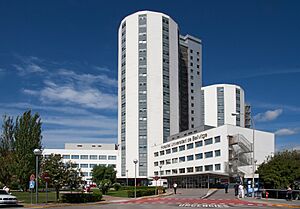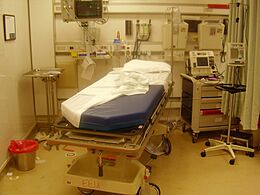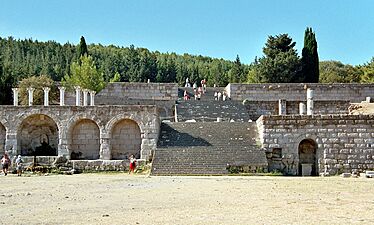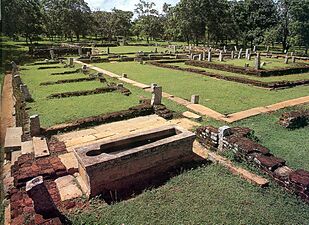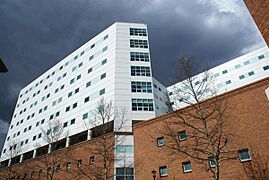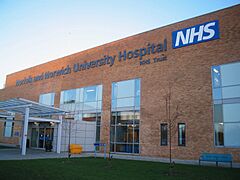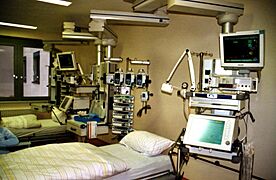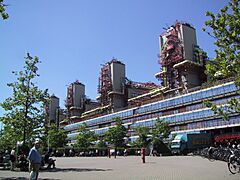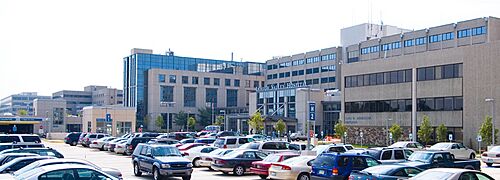Hospital facts for kids
A hospital is a special building where people go when they are sick or injured to get medical treatment. Hospitals have expert doctors, nurses, and other healthcare workers, along with special medical equipment to help patients get better.
The most common type of hospital is the general hospital. It has an emergency department to handle urgent health problems, like injuries from an accident or a sudden illness. A district hospital is usually the main healthcare center for a whole region, with many beds for patients who need serious medical attention, called intensive care, and for those who need to stay for a longer time.
There are also specialized hospitals that focus on certain types of care. These include children's hospitals for kids, rehabilitation hospitals to help people recover from major injuries, and hospitals that treat specific diseases like cancer. A teaching hospital is a place that not only treats patients but also teaches new doctors and nurses. A smaller health facility is often called a clinic.
Hospitals are usually paid for by the government, private companies, health insurance, or by charities. In the past, many hospitals were started and funded by religious groups or kind individuals who wanted to help others.
Where Does the Word "Hospital" Come From?
The word "hospital" comes from the Latin word hospes, which means "guest." In the Middle Ages, hospitals were not just for the sick. They were also places that offered "hospitality" to the poor or to travelers on a long journey, called pilgrims.
This is why the word "hospital" is related to other English words like hospitality, hostel, and hotel. All these words have to do with taking care of guests.
Different Kinds of Hospitals
People go to hospitals for different reasons. Some people, called "outpatients", visit for a check-up or treatment and go home the same day. Others, called "inpatients", are admitted to the hospital and stay overnight, sometimes for many days or weeks.
General Hospitals
A general hospital, also known as an acute-care hospital, is ready for almost anything. These hospitals treat many different kinds of illnesses and injuries. They almost always have an emergency department to handle urgent health problems right away. Big cities often have several general hospitals of different sizes.
Specialized Hospitals

A specialized hospital focuses on one or a few related areas of medicine. This helps them become experts in that type of care.
- Children's hospitals are designed just for kids.
- Rehabilitation hospitals help people recover their strength and skills after a serious illness or injury.
- Psychiatric hospitals care for people with mental health conditions.
- Other hospitals might specialize in treating cancer or heart problems.
By focusing on one area, these hospitals can sometimes offer care at a lower cost than a general hospital.
Teaching Hospitals
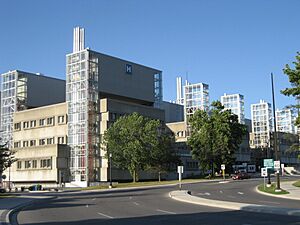
A teaching hospital does two jobs at once: it cares for patients and it trains future medical professionals. Medical students and student nurses learn by working alongside experienced doctors and nurses. These hospitals are often connected to a university and are also centers for medical research.
What's Inside a Hospital?
A hospital is divided into different sections called departments or wards. Each one has a specific job.
- Wards are rooms where inpatients stay in hospital beds.
- The Emergency department (or ER) is where people go for urgent medical problems.
- An Operating theatre is a special room where surgeons perform operations.
- The Intensive care unit (ICU) is for patients who are very sick and need constant monitoring.
- A pharmacy provides all the medicines needed for patients.
- Radiology is where doctors take X-rays and other images to see inside the body.
- Pathology labs test samples, like blood, to help diagnose diseases.
Many hospitals also have outpatient departments for services like dentistry or physical therapy.
A Brief History of Hospitals
Ancient Times and the Middle Ages
The idea of a place for healing has been around for a long time. In ancient Greece, people visited temples of the healing god Asclepius for medical advice. The Romans had military hospitals called valetudinaria for their soldiers.
After Christianity became a major religion in the Roman Empire, the building of hospitals grew. In the Middle Ages, Islamic cities like Baghdad and Córdoba had large, advanced hospitals called bimaristans. These hospitals treated the poor for free and were the first to require that doctors have licenses to practice medicine.
-
The ruins of an Asklepieion on the Greek island of Kos.
From the 1700s to Today
In the 18th century, the first "voluntary" hospitals opened in London, paid for by private citizens. These hospitals became centers for medical training and new discoveries. Famous hospitals like Pennsylvania Hospital in Philadelphia (1752) and Massachusetts General Hospital in Boston (1811) were also founded during this time.
The 19th century brought huge changes. Florence Nightingale, a famous nurse during the Crimean War, transformed hospitals. She introduced high standards for cleanliness and professional nursing. She helped change the hospital's image from a place where people went to die to a place of healing and recovery.
By the 20th century, discoveries like anesthesia (to prevent pain during surgery) and X-rays made hospitals the best place to get advanced medical care. Today, hospitals continue to evolve with new technology and a greater focus on patient safety and comfort.
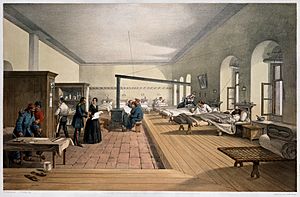
Hospital Design and Architecture
Modern hospitals are designed to be as efficient and safe as possible. The layout helps doctors and nurses move around quickly and reduces the spread of germs. Special areas like operating rooms and radiology departments need heavy equipment and careful planning for wiring and plumbing.
Many newer hospitals are also designed to help patients feel better. Research shows that good design can speed up recovery.
- Sunlight: Rooms with natural light can help reduce depression.
- Nature: Having a view of a garden or trees can lower stress and blood pressure.
- Private Rooms: Instead of large, open wards, many hospitals now use private rooms to give patients more privacy and rest.
-
The medical center at the University of Virginia shows a modern style of hospital architecture.
-
An intensive care unit (ICU) inside a hospital.
-
Lehigh Valley Hospital–Cedar Crest in Allentown, Pennsylvania, U.S.
Images for kids
-
All India Institute of Medical Sciences, New Delhi, a large teaching hospital in India.
-
A hospital ward in 6th century France.
-
An 1820 drawing of Guy's Hospital in London, one of the first voluntary hospitals, founded in 1724.
-
Ruins of the Hospital San Nicolás de Bari in the Dominican Republic, the oldest hospital built in the Americas.
-
Pennsylvania Hospital, the first public hospital in the United States, founded in 1751.
-
Cabell Huntington Hospital in Huntington, West Virginia (2014).
-
Clinical Hospital Dubrava in Zagreb, Croatia.
See also
 In Spanish: Hospital para niños
In Spanish: Hospital para niños
- Burn center
- History of hospitals
- History of medicine
- Hospice
- Hospital network
- Lists of hospitals
- Trauma center
- Walk-in clinic


